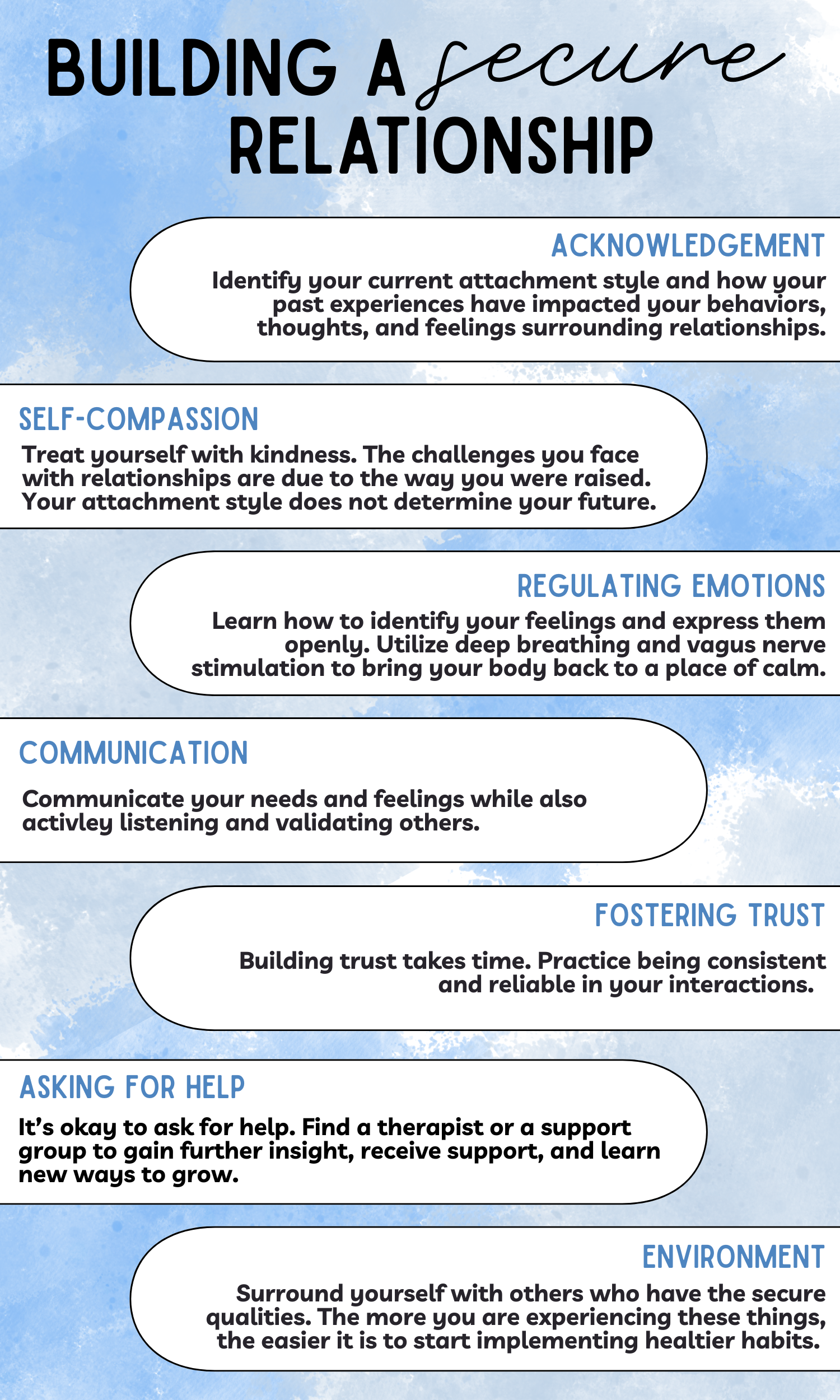Building a Secure Attachment Style: The Foundation for Healthier Relationships
Attachment styles are the blueprint for understanding how we connect, communicate, and form bonds with others. Our attachment style is shaped from our earliest experiences with parents or caregivers and impacts our relationships with others as adults. The four main attachment styles include: secure, anxious, fearful avoidant/disorganized, and dismissive avoidant. The goal is to reach a secure attachment that fosters trust, intimacy, and emotional well-being in our relationships.
Building a healthy relationship when our attachment style is not secure can be difficult. Learning how to address your thoughts, behaviors, and feelings in your current attachment style will allow you to work towards creating a healthier attachment and in turn, a healthier relationship.
Understanding Secure Attachment
A secure attachment style is characterized by confidence and trust in oneself and others. These are common characteristics of a person with a secure attachment.
Feeling comfortable with intimacy and independence.
Navigating conflicts constructively.
Communicating their needs and emotions openly.
Offering and receiving support in healthy ways.
Being secure doesn’t mean you’ll never face challenges or experience negative emotions in relationships; rather, it equips you with the tools and skills to handle these challenges effectively while maintaining balanced relationships.
Why Secure Attachment Matters
Having a more secure attachment allows you to have healthier relationships with others and yourself. This means:
Increased Emotional Resilience: Allows you to navigate challenges without losing your sense of self.
Healthier Communication: Increases open and honest communication which builds trust and respect in relationships.
Deeper Connection: It allows you to form meaningful bonds without fear of rejection or dependence.
Cultivating a Secure Attachment
Building a secure attachment style is a journey, especially if your experiences have led to anxious, avoidant, or disorganized tendencies. Start implementing the actionable steps below to begin the journey towards a more secure attachment.
1. Understand Your Current Attachment Style
Self-awareness is the first step. Reflect on your past and present relationships, noting patterns in how you respond to intimacy, conflict, and emotional needs. Understanding and identifying your current attachment style sheds insight into many of your current challenges or stress. Take a free attachment style quiz such as the one offered by “The Attachment Project” or meet with a therapist for further reflection.
2. Practice Self-Compassion
Healing starts with treating yourself with kindness. Acknowledge how your attachment style was shaped by past experiences, noting that it does not define your future. Practice empowering affirmations, mindfulness, and self-care to nurture a loving relationship with yourself.
3. Develop Emotional Regulation Skills
Being able to regulate your emotions is an integral part of being more secure in relationships. Starting to address your feelings and implementing habits that will improve your ability to regulate them will strengthen your relationships.
Identify your emotions
Notice how your body responds to emotions
Use deep breathing, vagus nerve stimulation, or meditation to calm your nervous system when heightened emotions are present
4. Communicate Openly and Assertively
Healthy communication is key to a secure attachment. Healthy communication involves:
Feeling comfortable expressing your needs without fear of judgment
Actively listening to others and acknowledging their feelings
Setting and respecting boundaries
5. Foster Trust Gradually
It takes time to build trust. Be consistent, reliable, and honest in your interactions, and seek partners or friends who demonstrate these qualities. Trust-building requires patience and mutual effort.
6. Seek Therapy or Support Groups
Finding support and guidance from a therapist or support group will give you further insight into your current attachment style and provide you with skills and insight into building more security.
7. Surround Yourself with Securely Attached People
Look for friends, mentors, or partners who exhibit traits of trustworthiness, emotional availability, and empathy. Surrounding yourself with those that already have a secure attachment helps you to see ways you can challenge yourself and grow.
Celebrating Progress
Cultivating a secure attachment style isn’t an overnight process, but every small step you take is a step towards progress. Celebrate that progress—whether it’s setting a boundary, managing heightened emotions, or expressing your needs with confidence. These moments signify your growth and commitment to building healthier and more secure relationships.
The Ripple Effect of Secure Attachment
When you cultivate a secure attachment style, the benefits extend beyond your personal relationships. You’ll find self-acceptance, increased emotional well-being, and the ability to be present in the world around you. The ripple effect can inspire others to embark on their own journeys toward healthier attachments.
By prioritizing a secure attachment style, you’re not just investing in your relationships, you’re investing in a brighter, more connected future for yourself and those you love.
